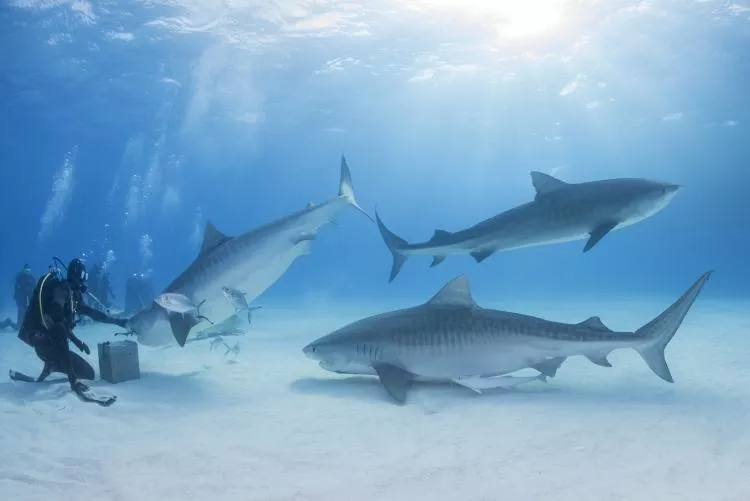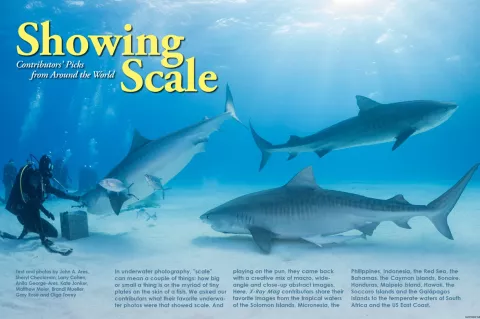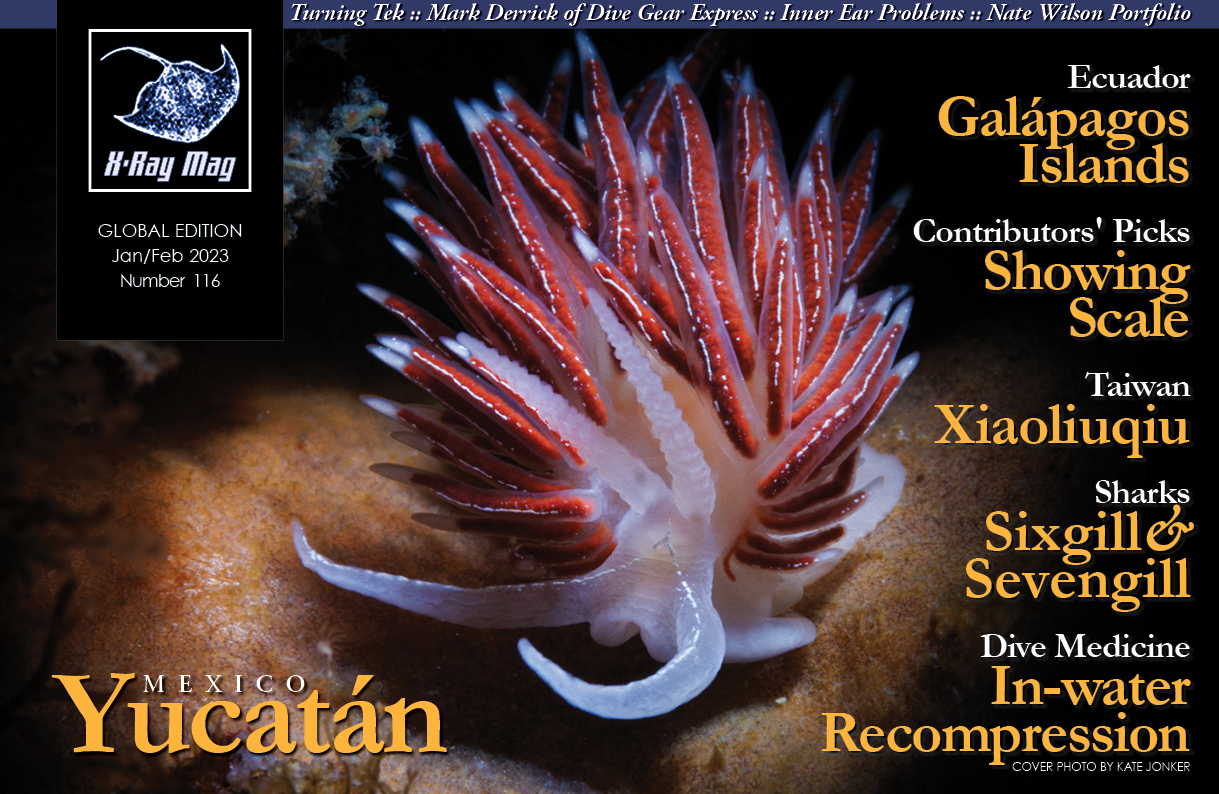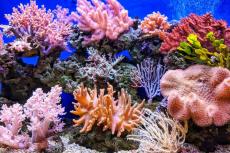In underwater photography, "scale" can mean a couple of things: how big or small a thing is or the myriad of tiny plates on the skin of a fish. We asked our contributors what their favorite underwater photos were that showed scale. And playing on the pun, they came back with a creative mix of macro, wide-angle and close-up abstract images.
Contributed by
(To see all images in the article, please scroll down to the end and download the PDF.)
Here, X-Ray Mag contributors share their favorite images from the tropical waters of the Solomon Islands, Micronesia, the Philippines, Indonesia, the Red Sea, the Bahamas, the Cayman Islands, Bonaire, Honduras, Malpelo Island, Hawaii, the Soccoro Islands and the Galápagos Islands to the temperate waters of South Africa and the US East Coast.
The Diver as Reference Point
Text and photos by Matthew Meier
For those viewers of underwater images that are unfamiliar with the incredible array of creatures, both big and small, hidden beneath the surface, a sense of scale helps to lend a point of reference from which they can place the subject into a world that they recognize. Adding a diver to the scene not only provides that reference point but I think it also allows the viewer to connect to the subject on another level. The human interaction makes it easier for the audience to relate on a more personal level and perhaps develop a sense of empathy and caring. From the weird and wonderful little creatures like the red-lipped batfish in the Galápagos, giant underwater caverns such as Ben’s cave on Grand Bahama Island, massive sea fans in the Solomon Islands that likely took decades (if not centuries) to grow, to impressive apex predator interactions with colossal tiger sharks at Tiger Beach, each of these photos gives the observer a glimpse into the underwater realm and hopefully provides a connection to something that they may never get a chance to see for themselves. Visit: MatthewMeierphoto.com
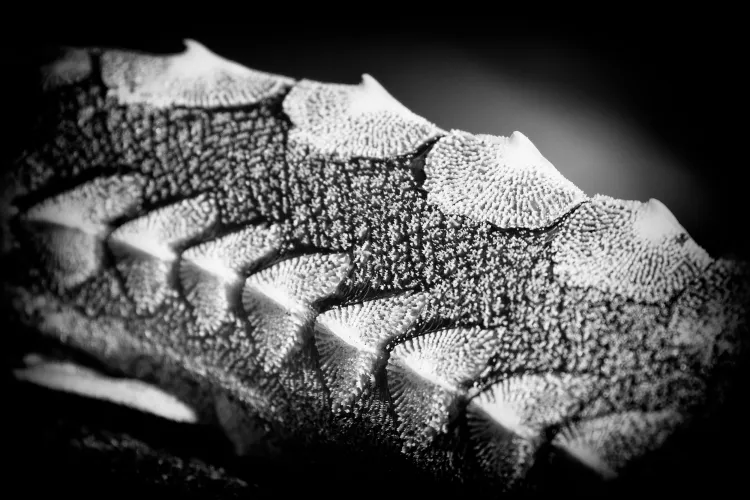
Scale Textures
Text and photos by John A. Ares
The photos presented here were originally part of a project I had been compiling for a while, under the keyword “texture.” Scales are features found on both fish and reptiles.
The juvenile Atlantic sturgeon (Photo 1) was washed up on the beach in Staten Island, New York, and had been there for quite some time. The scale pattern was still intact and fascinating. The image was converted to black and white using NIK Silver Efex software.
The cowfish (Photo 2) had compelling scales that scream. Scales can camouflage or make the fish stand out strikingly, as in this instance in Bonaire.
The skin or scale pattern of the flounder (Photo 3) helped it blend in with the bottom in Bonaire.
Shark scales differ from that of bony fishes and are called dermal denticles or placoid scales.[1] The whitetip reef shark (Photo 4) was particularly tolerant while getting its portrait taken. It is not a normal practice to shoot sharks with a 100mm macro lens. The resulting photo was a happy accident taken in Kauai, Hawaii.
The image was converted to black and white using NIK Silver Efex software. Selective color was then applied, using the techniques I wrote about in my article Selective Color in Underwater Photography in X-Ray Mag #110. Visit: JohnAres.com
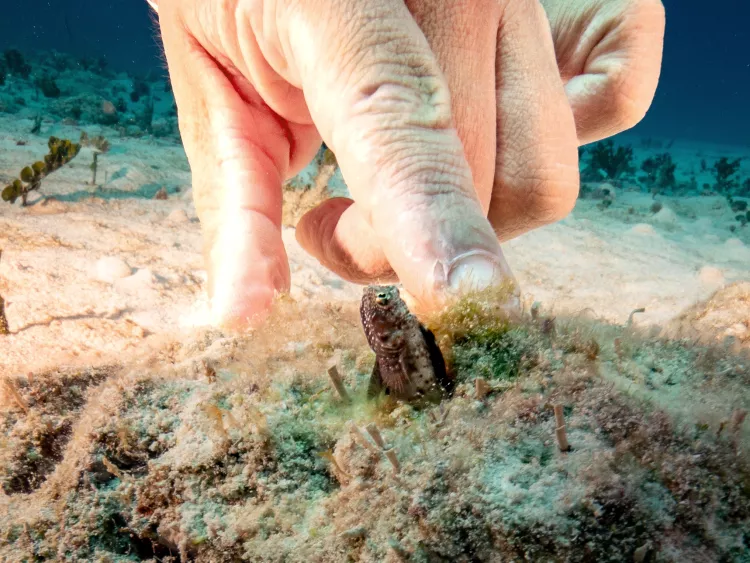
Context
Text and photos by Sheryl Checkman
Life beneath the sea comes in all different sizes—from the barely visible varieties of nudibranchs and blennies to enormous pelagics, like whales and whale sharks. When viewing photographs of these animals, it is often difficult to judge the scale without some form of context. When shooting macro subjects, we often fill the frame with our subject, closing in to get detail, but losing sight of just how small that critter actually is.
In Little Cayman, while diving on Cumber’s Caves, my buddy and I spotted a spinyhead blenny (Photo 1) poking its head out of the sand. In order to show just how small this blenny was, my buddy placed her index finger alongside it.
In Roatan, I encountered a bluestriped fangblenny (Photo 2) on sunray lettuce coral, while on a dive at Sponge Wall. The neon bluestriped fangblenny, lying on top of the comparatively larger coral’s linear ridges, stands out as a tiny, curved line, while at the bottom of the image, another tiny blenny (only noticeable by its dark eyes) almost blends in with the similarly colored coral.
The same idea goes for photographing large animals. I once photographed a 30ft whale shark but neglected to have a photo of a diver in the frame to give the photo scale. In photographing the over 6ft gray reef shark (Photo 3), also in Roatan, at the dive site Cara-a-Cara Marco’s Place, I showed just how large this shark was by photographing fellow diver and photographer Brandi Mueller beside it.
On a night dive in Roatan on Emily’s Escape Wall, if you look closely, you can see the small Pederson’s cleaner shrimp giving this spotted scorpionfish a cleaning. Visit: Instagram.com/sherylcheckman
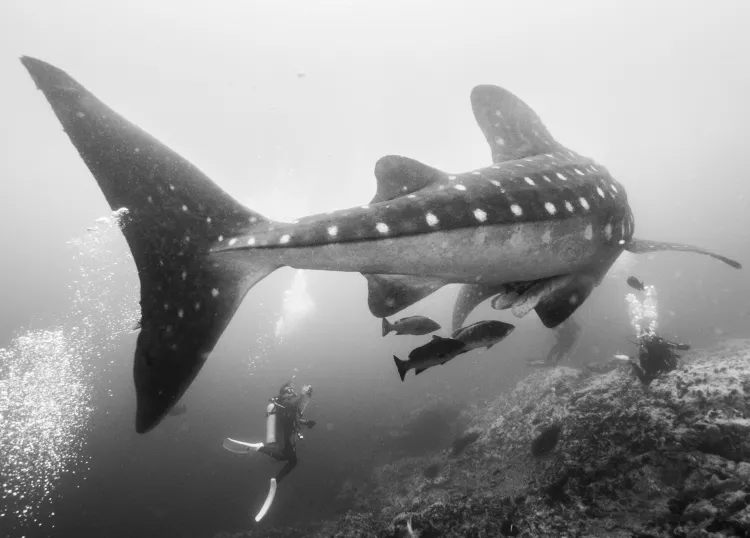
Wrecks & Whale Sharks
Text and photos by Larry Cohen
When taking photos underwater, the viewer does not get a sense of the subject’s size unless there is a familiar object in the image. By adding a diver to the image, the viewer can automatically judge the size of everything in the photograph.
When diving Malpelo Island in the Pacific Ocean, 400km west of the Colombian mainland, we encountered the largest fish in the world: a whale shark. Usually, whale sharks are observed feeding at the surface. But instead, this friendly fish enjoyed our company and stayed with us on the deep walls. This allowed plenty of time to capture images at different angles. Usually, I do not show pictures of the backside of marine life, but I found this image of the whale shark’s tail appealing. In addition, the divers taking photos of the whale shark adds scale and a human element to the photograph.
Diving and documenting shipwrecks is always exciting. There is no better location than Chuuk Lagoon in the Federated States of Micronesia. The US Navy attacked the area on 17 to 18 February 1944, in what is known as Operation Hailstone. For this reason, many Japanese shipwrecks are in this small lagoon.
The San Francisco Maru carried many supplies for the Japanese war effort, including several small Type 95 Ha-Go tanks. They are in 165ft of water, on the deck. By having a diver swim over the tank, the viewer of the photos has a better idea of how small these tanks are. I took this image with and without strobes, then decided that the image taken with ambient light was more dramatic.
The wreck of the Aikoku Maru is also in Chuuk Lagoon. One of the best photo locations is the large stern gun. This anti-aircraft gun is still pointing up, trying to protect the ship from the Avenger aircraft that sent the freighter to its resting place. Again, having a diver in the photo is essential to get an idea of the size of this gun. I also found this image to be better using only ambient light. Visit: liquidimagesuw.com
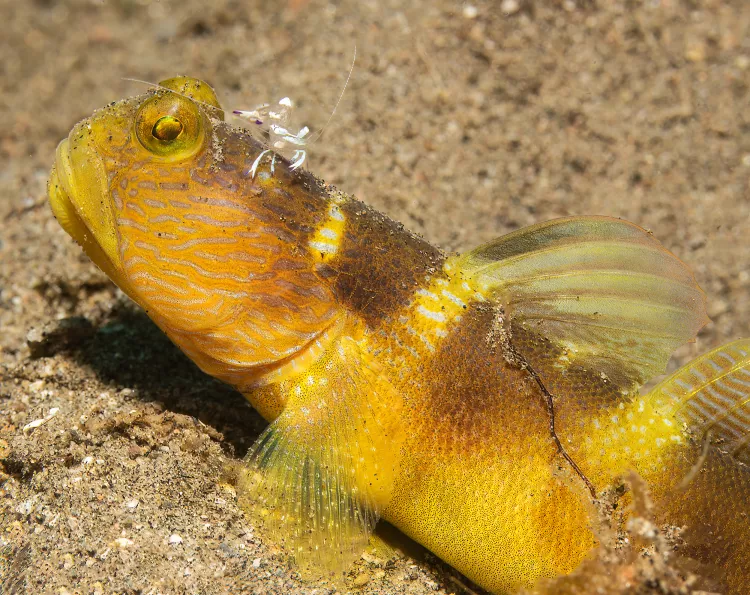
Roommates
Text and photos by Anita George-Ares
Photographing different species of shrimp gobies and their partner shrimps is a fun project for me. The slantbar shrimp goby and its resident tiger pistol shrimp in Photo 1 were particularly relaxed. Normally, I must approach a shrimp goby burrow slowly and patiently wait for the pistol shrimp to emerge. The goby stands guard duty while the shrimp constantly clears the burrow of excess material.[2] When I visited another shrimp goby burrow, I was delighted to find a cleaner shrimp on top of a banded shrimp goby’s head (Photo 2).
A bubble coral shrimp and two common ghost gobies share a bubble coral home in Photo 3. The ghost gobies reach a length of about 3cm, while the bubble coral shrimp grows up to 1.5 cm. I like the proximity of the gobies and shrimp in addition to the warm colors of this image.
A juvenile red emperor snapper shelters among the venomous spines of a blue-spotted urchin in Photo 4. Juveniles, 3 to 13cm long associate with the urchins (Allen et al., 2015).[3] Juvenile snappers, less than 20cm long also closely associate with lionfish (Seveso et al., 2018).[4] Please visit: facebook.com/profile.php?id=100016947967639
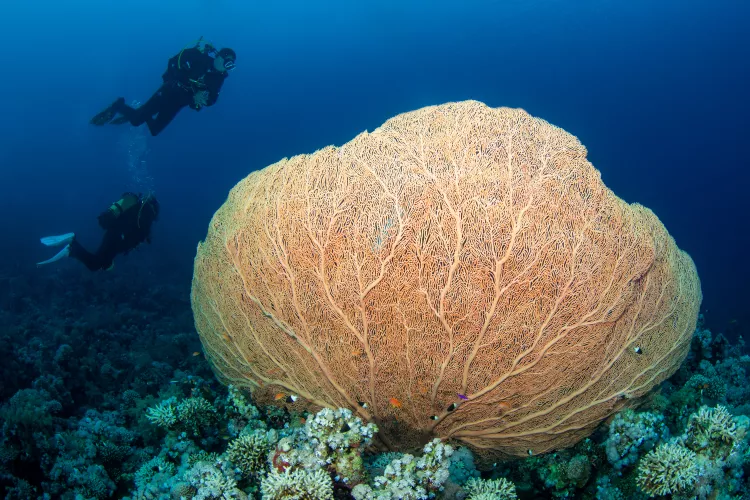
Adding a Sense of Scale
Text and photos by Kate Jonker
When one dives into the world of underwater photography, things are not always as they seem. A photo of a nudibranch can fill a page, while an image of a wreck can give the impression of being small and unassuming. What can we, as underwater photographers, do to give our viewers a sense of scale? And is it always important to do so?
When photographing wrecks, we can add divers. Adding a diver gives a good frame of reference to the size of the wreck, especially if there is no reef or other structure close by to compare it to.
Furthermore, when capturing large reefs or huge gorgonian sea fans, especially those that flourish in the nutrient-bearing currents in the Red Sea, including a diver can add a sense of scale. Non-divers, or those who have never seen these enormous sea fans before, will be amazed. The sheer size of the sea fan compared to a diver next to it can be breathtaking!
On the smaller end of the scale, monstrous-looking creatures that appear to be the size of a small puppy can turn out to be super-macro photos of critters no larger than of a grain of rice. In macro photography, the absence of a sense of scale can be used creatively, resulting in gasps of wonder when the actual size of the creature photographed is revealed.
In underwater photography, a sense of scale can amaze and intrigue the viewer. It all boils down to how the photographer chooses to use it! Visit: katejonker.com
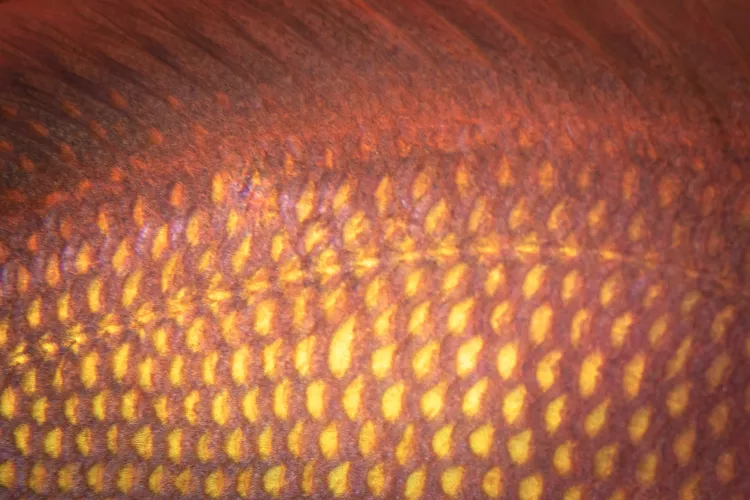
Fish Scales Up Close
Text and photos by Brandi Mueller
Fish scales or close-up macro shots of marine creatures is one of my favorite photographic subjects. I love the intricate color patterns and textures of fish scales, and I find the variety and variations amazing. It is often my “go-to” on days where visibility is bad or there does not seem to be much going on underwater. If you look closely, there is always plenty to photograph and see.
For instance, parrotfish never disappoint, and colors vary from fish to fish. (Keep an eye out for the most colorful alpha females.) Scales can vary with tones of blue, green, yellow, pink and purple. Bluefin trevally can have yellow, purple and blue tones and spots, and almost glisten like a metal reflection.
A small pink anthia seems to glitter as it flits about, and its scales are yellow dots surrounded by pink. I also could not resist putting in a photo of an epaulette shark. Shark scales are flexible and called dermal denticles; they are teeth-like structures that feel like sandpaper. Visit: brandiunderwater.com
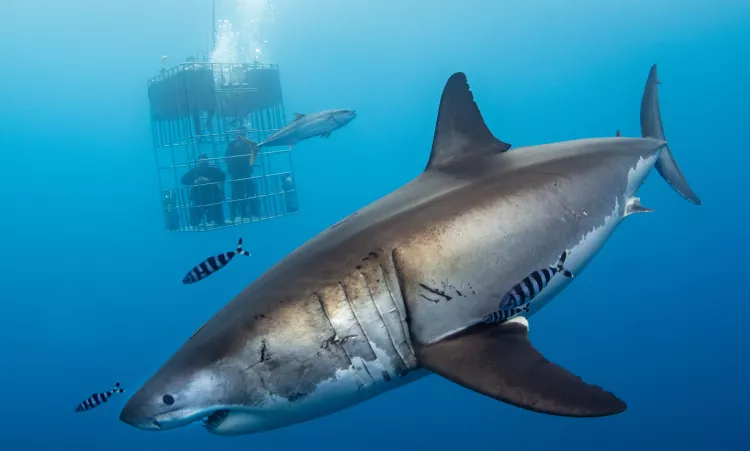
Scale Matters
Text and photos by Gary Rose, MD
When I give my “Shark Behavior and Identification” lecture, it does not matter where in the world, or to which group I am giving it to, someone in the audience will shout, “That great white shark is huge!” or “I have never seen one so big!” In Photo 1, you can clearly see why.
This beautiful great white shark truly looks gargantuan and of epic proportion. The divers in the cage are dwarfed. And that is exactly the point. If you want to emphasize size, you need to include a size reference in the photo. It is also fun to play with the size reference to create an effect like this. In this photo, the divers in the cage are 30ft behind the sharply focused and light-bathed great white shark. Let’s look at a few more examples.
In Photo 2, the whitetip reef shark looks large, but not of epic proportion. I was originally taking this photo of the diver to show the steep and deep drop-off of the wall at Roca Partida, when this whitetip reef shark photobombed the photo. It clearly added to the beauty of the scene and emphasized the grandeur of the wall, as well as supplied an element of 3D to the photo. It does look larger than its 6ft length, swimming 10ft closer to me, and becomes part of the photo—not “the photo,” as we saw with the great white shark.
Shooting up from below, with the diver reaching up, almost as if she is touching this beautiful giant manta ray, diminishes the actual size and importance of the manta in Photo 3. The giant manta appears to have a four-foot wingspan, compared to the size of the diver, and appears to be casually passing above the diver. This would be considered a dramatic photo if it was about the diver and not the manta.
In Photo 4, again shooting up, the diver is viewed immediately beneath a giant manta ray. The proximity of the diver and the ray places the scale in proper perspective, allowing the viewer to appreciate the majesty of this giant manta with its 18ft wingspan. This proximity permits the viewer to properly judge scale by properly using the diver as a size reference. This photo emphasizes the very real connection between the diver and the giant manta ray.
Scale matters.” To prove this point, let’s look at Photos 3 and 4. The viewer might assume that these are two different giant manta rays, one being relatively small, and the other a more typical giant. Look again. Now, observe the identifying markings on the underside of the manta in each image. The ventral markings are identical. It is the same magnificent giant manta ray in each photo.
Supplying the scale in these examples, with a diver and positioning, allowed me to completely alter the viewer’s interpretation and enjoyment of each of these photos. Visit: garyrosephotos.com
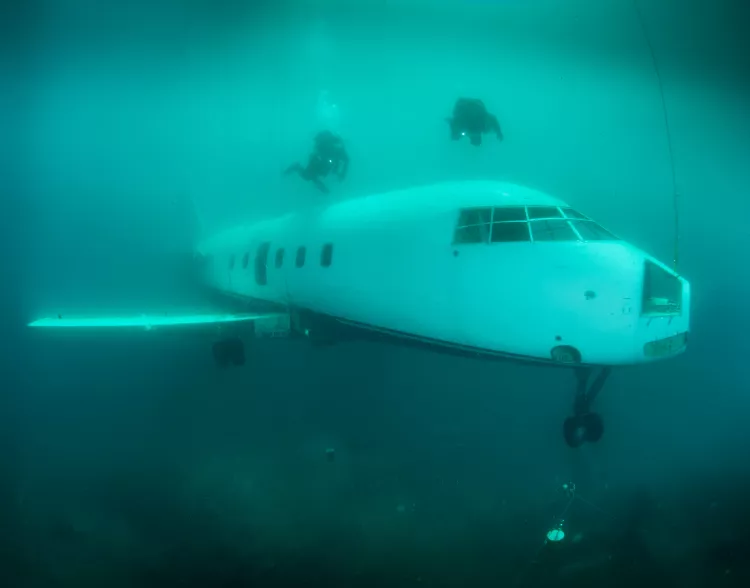
From Jets to Rays
Text and photos by Olga Torrey
In March 2016, my dive partner Larry Cohen and I were on the photography team that documented the sinking of a Challenger 600 aircraft in the 50-acre freshwater lake known as Dutch Springs in Pennsylvania, USA. The plane sank to 45ft in cold water. The Challenger 600 series business jet replaced the Sikorsky CH-37 helicopter, another favorite attraction for divers at the quarry. My friend Pete Venoutsos, Larry and I were excited to check out the new dive site the following weekend. I used both divers as a human element for scale when photographing the plane’s length, which was 20.9m (68ft 5in), and wing area of 45.4 sq m (489sq ft).
It was the year 2018 when I first saw a giant Pacific oceanic manta ray. For a long time, I had wanted to visit the Revillagigedo Islands (Socorro) in Mexico to see these majestic creatures. I traveled there on the luxurious Nautilus Belle Amie liveaboard. On the last day of the trip, we swam with ten manta rays, which engaged us with their graceful acrobatic movements. I used the divers as a human element to show the scale of these giant manta rays, which can be impressive in size, with bodies up to 9m (30ft) in length, weighing about 3,000kg (6,600 lbs).[5]
My first visit to Kailua-Kona in Hawaii, USA, was in October 2019. The trip’s highlight was the night diving and snorkeling with pelagic manta rays. In addition to the rays, we met a lovely young diver, Angelique Reinke, who came along to do night snorkeling with the mantas. We used lights to attract plankton, which attracted the mantas rays. The animals were active, giving us plenty of opportunities to capture them in action. For one shot, I asked Angelique to swim in the direction of my light and align herself near a giant ray.
In October 2018, I visited Papua New Guinea. It was a childhood dream of mine to go to this mysterious and faraway place. Finally, my dream came true, and I set my foot on the same ground where the 19th-century explorer Nicholas Miklouho-Maclay, whom I had learned about in school, had lived and studied the indigenous people.
My favorite location in Papua New Guinea was Tufi Resort. It was an excellent location for macro and wide-angle photography. The colorful corals on vertical walls at Gabriella’s Fish Point were healthy and enormous. I asked the dive guide to swim toward the giant barrel sponge, at a distance, to emphasize its size in the shot. Visit: fitimage.nyc
[1] wikipedia.org
[2] Explorebiodiversity.com
[3] Allen, G., R. Steene, P. Human, and N. Deloach. (2015). Reef fish identification tropical Pacific. New World Publications, Inc.
[4] Seveso, D., S. Montano, and D. Maggioni. (2018). In the shadow of the lionfish: interspecific association involving red emperor snapper (Lutjanus sebae) in Madagascar. Coral Reefs 37 (4):1. DOI:10.1007/s00338-018-01747-8
[5] wikipedia.org

